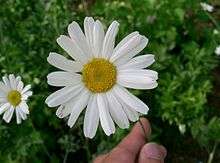Pyrethrum
Pyrethrum was a genus of several Old World plants now classified as Chrysanthemum or Tanacetum (e.g., C. coccineum) which are cultivated as ornamentals for their showy flower heads. Pyrethrum continues to be used as a common name for plants formerly included in the genus Pyrethrum. Pyrethrum is also the name of a natural insecticide made from the dried flower heads of Chrysanthemum cinerariifolium and Chrysanthemum coccineum.
Description
Some members of the Chrysanthemum genus, such as the following two, are placed in the Tanacetum genus instead by some botanists. Both genera are members of the daisy (or aster) family, Asteraceae. They are all perennial plants with a daisy-like appearance and white petals.
- T. cinerariifolium is called the Dalmatian chrysanthemum, denoting its origin in that region of the Balkans (Dalmatia). It looks more like the common daisy than other pyrethrums do. Its flowers, typically white with yellow centers, grow from numerous fairly rigid stems. Plants have blue-green leaves and grow to 45 to 100 cm in height. The plant is economically important as a natural source of insecticide. The flowers are pulverized and the active components, called pyrethrins, contained in the seed cases, are extracted and sold in the form of an oleoresin. This is applied as a suspension in water or oil, or as a powder. Pyrethrins attack the nervous systems of all insects, and inhibit female mosquitoes from biting. When present in amounts less than those fatal to insects, they still appear to have an insect repellent effect. They are harmful to fish, but are far less toxic to mammals and birds than many synthetic insecticides and are not persistent, being biodegradable and also decompose easily on exposure to light. They are considered to be amongst the safest insecticides for use around food. Kenya produced 90% (over 6,000 tonnes) of the world's pyrethrum in 1998, called py for short. Production in Tanzania and Ecuador is also significant. Currently the world's major producer is Tasmania, Australia.
 Tanacetum cinerariifolium
Tanacetum cinerariifolium - C. coccineum, the Persian chrysanthemum, is a perennial plant native to Caucasus and looks somewhat like a daisy. It produces large white, pink or red flowers. The leaves resemble those of ferns, and the plant grows to between 30 and 60 cm in height. The flowering period is June to July in temperate climates (Northern Hemisphere). C. coccineum also contains insecticidal pyrethrum substances, but it is a poor source compared to C. cinerariifolium.
 Tanacetum coccineum
Tanacetum coccineum - Other species, such as C. balsamita and C. marshalli, also contain insecticidal substances, but are less effective than the two species mentioned above.
Insecticides
Sprays
Pyrethrum has been used for centuries as an insecticide,[1] and as a lice remedy in the Middle East (Persian powder, also known as "Persian pellitory"). It was sold worldwide under the brand Zacherlin by Austrian industrialist J. Zacherl.[2] It is one of the most commonly used non-synthetic insecticides allowed in certified organic agriculture.[3]
The flowers should be dried and then crushed and mixed with water.
- Pyrethroids are synthetic insecticides based on natural pyrethrum (pyrethrins); one common example is permethrin. A common formulation of pyrethrin is in preparations containing the synthetic chemical piperonyl butoxide: this has the effect of enhancing the toxicity to insects and speeding the effects when compared with pyrethrins used alone. These formulations are known as synergized pyrethrins.
Toxicity
Rat and rabbit LD50 levels for pyrethrum are high (safe), with doses in some cases of about 1% of the animal's body weight required to cause significant mortality similar to levels in synthetic pyrethroids.[4] Nevertheless, pyrethrum should be handled with the same caution as synthetic insecticides.[5]
People can be exposed to pyrethrum as a mixture of cinerin, jasmolin, and pyrethrin in the workplace by breathing it in, getting it in the eyes or on the skin, or swallowing it. The Occupational Safety and Health Administration (OSHA) has set the legal limit (Permissible exposure limit) for pyrethrum exposure in the workplace as 5 mg/m3 over an 8-hour workday. The National Institute for Occupational Safety and Health (NIOSH) has set a Recommended exposure limit (REL) of 5 mg/m3 over an 8-hour workday. At levels of 5000 mg/m3, pyrethrum is immediately dangerous to life and health. People exposed to pyrethrum may experience symptoms including pruritus (itching), dermatitis, papules, erythema (red skin), rhinorrhea (runny nose), sneezing, and asthma.[6]
Companion planting
Because chrysanthemums contain pyrethrums, they are used as companion plants to repel pest insects from nearby crops and ornamental plants.[7] They are thought to repel aphids, bed bugs (Cimex lectularius), leafhoppers, spider mites, harlequin bugs, ticks, pickleworms, and imported cabbage worms, among others, in gardens and farms. For example, they are planted among broccoli plants for protection from several common insect pests.
Common names
Common names for Chrysanthemum cinerariifolium include:
- Pyrethrum
- Pyrethrum daisy
- Dalmatian pyrethrum
- Dalmatian chrysanthemum
- Dalmatian insect flower
- Dalmatian pellitory
- Big daisy
Common names for Chrysanthemum coccineum include:
- Pyrethrum
- Pyrethrum daisy
- Painted daisy
- Persian chrysanthemum
- Persian insect flower
- Persian pellitory
- Caucasian insect powder plant
See also
- Chrysanthemum
- List of companion plants
- Category: Plant toxin insecticides
- Permethrin
- Pyrethrin
References
- ↑ Bioaromatica The history of pyrethrum
- ↑ US patent 308172, Johann Zacherl, "Pyrethrum Soap", issued 1884-11-18
- ↑ Some Pesticides Permitted in Organic Gardening, by Laura Pickett Pottorff, Colorado State University Cooperative Extension, January 5, 2010.
- ↑ Pesticide Toxicity Profile: Synthetic Pyrethroid Pesticides, by Frederick M. Fisher, University of Florida IFAS Extension Service, 2013
- ↑ insecticide (botanical, mineral, synthetic) toxicity to mammals Electronic Data Information Source of University of Florida
- ↑ "CDC - NIOSH Pocket Guide to Chemical Hazards - Pyrethrum". www.cdc.gov. Retrieved 2015-10-23.
- ↑ Riotte, Louise (1998). Carrots Love Tomatoes. North Adams, MA: Storey Publishing, LLC. p. 72. ISBN 978-1-58017-027-7.
External links
- National Pesticide Information Center: Pyrethrins and Pyrethroids Fact Sheet
- CDC - NIOSH Pocket Guide to Chemical Hazards
- EXTOXNET: Pyrethrins and Pyrethroids
- "What is Pyrethrum?"
- "International Center for Pyrethrum Research"